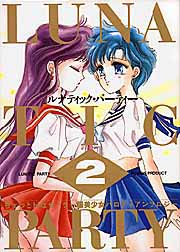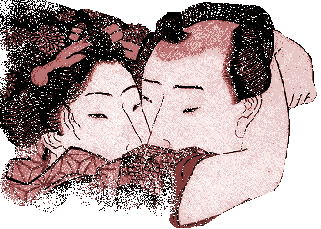|
|
|
THE
EROTIC ART OF THE FLOATING WORLD
|
|
In
the Japan of the 1800's, the color woodcut print
was the most popular artform of the day. The artists
of the so-called floating world or ukiyo-e
portrayed real life personages and situations as
the subject matter for their wood block prints.
Ukiyo-e artists created extraordinary portraits
of Kabuki Actors, Geisha, Sumo Wrestlers, and other
notables, as well as landscapes and architectural
views of old Japan. The incredible artistic output
of these highly skilled artists left us an accurate
view of life in the Japan of yesteryear. There was
however another aspect to the art of the ukiyo-e
that few Westerners have heard of, that is the art
of shunga, or... the Images of Spring.
The
production of such images kept most ukiyo-e artists
very busy. In fact there were no artists of the
time who remained uninvolved with the creation of
shunga. The artists of the floating world many times
created highly charged sexual imagery, erotic imagery,
what Westerners would categorize as "pornographic"
pictures. Ukiyo-e artists created these "Images
of Spring" without the slightest notion of
embarrassment or shame.
|
|
|
The
sexually explicit nature of shunga wood block
prints prevents me from displaying the full
images... since many minors visit this site.
I've preferred instead to present some wood
cut images that I've edited and cropped. Even
in this edited form the nature of these prints
is most apparent. Shunga prints are of such
a risque nature as to make even the most liberal
minded person blush!
|
|
There
was no stigma attached to the production, sale,
or purchase of shunga artworks, in fact the market
for such artworks was a lively and lucrative one.
Erotic images were not illegal and collections of
shunga were sold in book form, called enpon.
This
artistic output on the part of Japanese artists
had no equivalent in the Western art of that time
and illustrates a completely different attitude
about sex and morality. The aesthetics of shunga
reflected the Japanese view of the body and sex
as being part of the natural world, a world that
held no concept of original sin.
|
|
|
|
It
was a longstanding tradition that brides of feudal
lords bring a collection of shunga to go along
with their wedding furniture. There was also a
tradition of feudal lords placing shunga in their
helmet box whenever they had a new suit of armor
made. These customs were a talismanic wish for
eternal happiness and many artists made a comfortable
living as a result.
|
The
sale of shunga to a high-ranking person would
bring enough money to sustain an artist for months,
and so many notable, first rate and highly accomplished
artists devoted themselves to this unprecedented
artform. The level of detail with which ukiyo-e
artists portrayed the human body revealed complete
familiarity with anatomy and sexuality. Practically
speaking the "Images of Spring" also
served as a form of sex education for the sons
and daughters of the well to do. This type of
frank, accurate, and free representation of sexual
matters was not to be seen in the West for at
least another one hundred and fifty years.
There
is limited knowledge of this artform outside of
Japan, and in Japan itself shunga is scarcely seen
or spoken of these days. However, the aesthetics
of shunga still resonate in the contemporary world
of certain manga and anime productions. The
venerable art of shunga is the root for some modern
day Japanese adult comic titles like Lunatic
Party (pictured below), proving without a doubt
that eroticism in contemporary anime and manga is
not at all a new phenomenon copied or borrowed from
the West.
|
|
Those
who are well acquainted with Japan's enormous manga
industry should be familiar with the genre of comic
known as hentai (or "perverted").
These contemporary publications often focus on explicit
"adult" material, but they have a clear artistic
connection to the past in that their themes can
be traced back to shunga. Shunga artworks are much
more than mere "dirty pictures."
The
prints are of considerable artistry and cultural
importance. In fact quite a few prestigious art
museums around the world, especially in Japan, have
collections of the highly prized risque prints (though
they are not generally on public display).
|
 |
|
Some
scenes portrayed in shunga prints involve tender
courting and romance, with all the attendant trappings
of flirtation. Many of the prints offer scenes that
leave nothing to the imagination. Couples are pictured
in states of partial undress, in the throes of passionate
lovemaking, utilizing a variety of positions and
techniques.
There
are even prints that depict lovely young ladies
pleasuring themselves, a sight nearly totally absent
from the annals of Western art! Whatever the sensual
delights portrayed, the prints always manage to
do so with sophistication and a certain elegance.
Shunga prints are one of the overlooked treasures
of traditional Japanese fine art. The "Images
of Spring" should be properly recognized as
high art, and at the same time preserved and studied
for being one of the world's greatest graphic art
forms.
|
|
 |
|